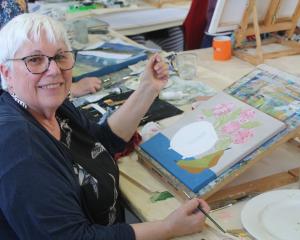
Nichola Shanley
(Brett McDowell Gallery)
Nichola Shanley’s November 2025 exhibition features an installation of silk wall hangings with a series of porcelain candle sconces in carbon blacks and glossy golds, a quilt and a hand-painted jacket made in collaboration with Lela Jacobs.
Through the characteristically lush and spontaneous mark making, Shanley’s work channels a range of aesthetic and decorative art historical themes: elaborations like the reflective shields or panels of glass that emerged in the candle sconces of 17th century Western European design, for example.
Affixed directly to the wall, and directly through the silk fabric, the sconces and candleholders are contextualised by the compositional elements of the silk paintings — figures entwine and are entwined in fabric, for example, and troubled portraits sit among abstract forms and swathes of warm and layered colour.
Visitors are also drawn into the work through small mirrors in many of the sconces. They are positioned so that only a part of the body can be seen reflected according to the viewer’s height: a glimpse of one’s neck, lips or eyes, for example.
The mood of the work conveys a dark romanticism. Deeply intuitive forms play across the borders of the sacred and profane — where the votive and the grotesque meet a domestic interior-scape. This body of work is richly world-building and so quite wonderful for the viewer.

(Olga Gallery)
"Semblance" is a collection of works that span the past 10 years of Philip Madill’s drawing practice. Exploring the concept of mediated reality and the absurd, Madill creates strange visual juxtapositions of the real and the imagined.
Drawing on historical photography and ephemera, Madill confuses the logical connections between given things. In this way, the viewer is invited to play with the interpretation of the work, making observations and drawing conclusions that remain open and speculative.
Sometimes the work conveys a naive believability, in that the objects and people in them could be documented real events or things that exist or have had some historical use. The eye wants to believe. In Fly by Wire (2016), for example, a man wears a cylindrical helmet-type device; a type of automotive unit or electronic interface with attached wires.
In another work, The Hollow Tree (2025), we see an image of the legs of a tall figure, appearing to observe two tiny figures putting up the framing of a house. Representative believability has been obviously cast aside for something more acutely allegorical in tone.
The layered representations at play are sometimes scary, often humorous and always generative, oscillating between the subjective and objective terms of meaning making.

(Slant Art Project Space)
That Was Their One Tree Hill is a video installation made in parallel with a sculptural installation, Under the Bridge, at the Arts House Trust in Tāmaki Makaurau. Both shows by Eva During walk their audiences through literal and personal landscapes tracing the artist’s own migration to Aotearoa New Zealand as a young adult and the journeys of early Chinese migrants through the historical gold-mining geographies along the Clutha River.
The two shows are connected yet distinct. Under the Bridge consists of hundreds of hand-made "shā bāo" — small stitched bags filled with beans, corn, barley, or wheat imprinted with fallen leaves and branches that During collected while travelling the Clutha River landscapes. That Was Their One Tree Hill includes film footage from this journey, but expands the scope to include other locations significant to During’s own experiences.
That Was Their One Tree Hill, while featuring the landscape, is also abstracted from it. The primary engagement for the viewer is the work’s compelling narrative form. During shares poetically crafted and delivered perspectives, reflections and events that bridge personal and cultural geographies and histories, connecting physical place and notions of belonging — an auto-ethnographic project that is critically aware, grounding and engaging.
Texts by Bridie Lonie, Sarah McGaughran and Wesley John Fourie accompany the exhibition.












